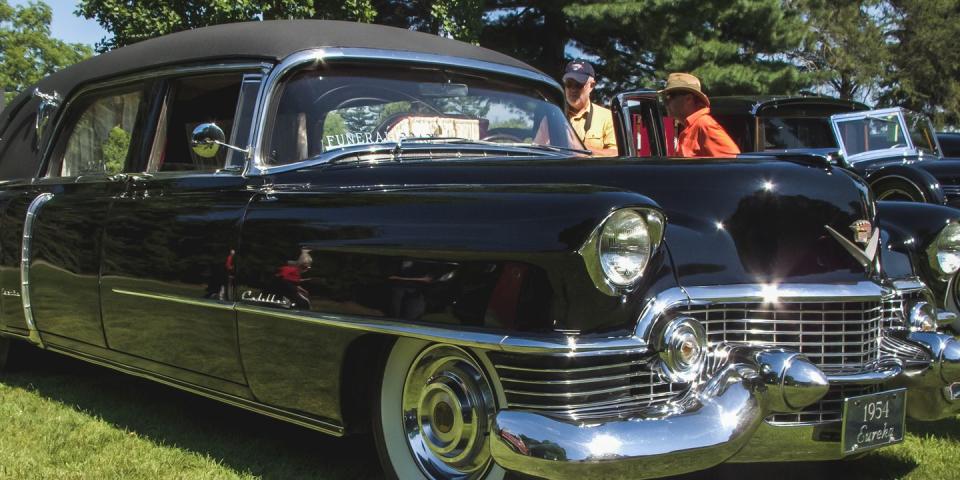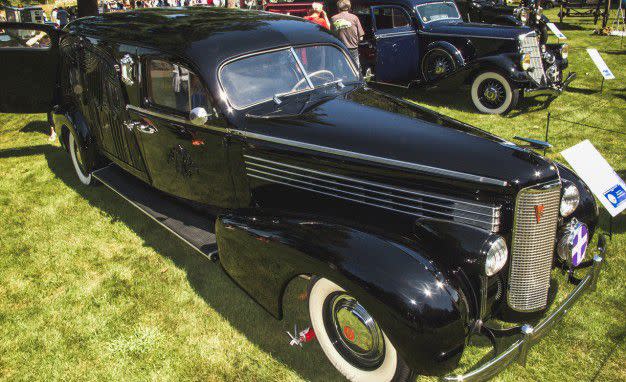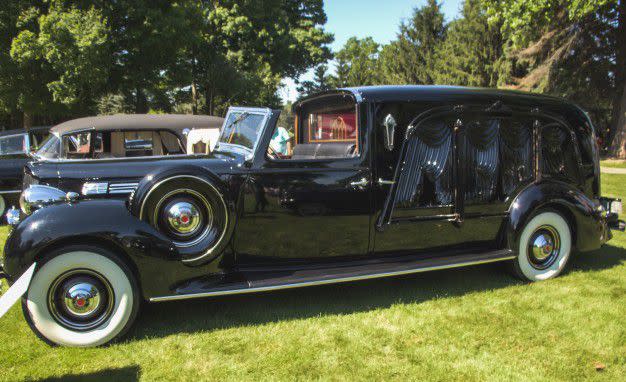Paint It Black: The Not-So-Humble Hearse Gets Its Day in the Sun

The trade calls it a “funeral coach” but everyone else just calls it a hearse, the last car you’ll ever ride in. Those who take that ride tend not to buy any more cars, though, so the nostalgic impulse that fuels much of the collector car scene rarely takes hold. Little wonder, then, that the Concours d’Elegance of America at Saint John’s in Plymouth, Michigan, could boast that it was the first major concours to devote an entire class to these coachbuilt machines at its 2015 show on July 26.
Perfect timing. The National Funeral Directors Association projects that 2015 will be the first year in which more dead Americans are cremated than are buried, the tipping point in a trend that’s been growing since Jessica Mitford’s The American Way of Death was published in 1964. It did for the funeral industry what Ralph Nader’s Unsafe at Any Speed did for Detroit a year later.
Since the vehicle’s role is to carry a body in a casket to the cemetery, leading a procession of motorized mourners, the hearse seems destined to join the telephone booth and the cabinet-size radio as a movie prop to signify an era in time. The concours at Saint John’s mustered these outstanding examples.
1916 Winton by Crane and Breed
Horse-drawn hearses gave way to the motorized variety less than a decade before this example was built in Cincinnati by Crane and Breed on a six-cylinder, 75-hp Winton chassis. Elaborate wood carvings on the sides were designed to resemble pillars and heavy drapes used in the earlier carriages. Those had big windows to let bystanders view the deceased-or the coffin, likely to be as over-decorated as the car-as the procession passed. A period ad for Crane and Breed contained this pleasant bit of doggerel:
“I am the Hearse-Death’s Taxicab; the Carriage of the Dead!
None Ride with Me but Once.
Thereafter Upon Earth-Their Riding Days are Over.”
1934 Pierce-Arrow Arrowline Henney 3-Way Funeral Car
The 3-Way was an innovation that allowed the casket to be loaded from either side or through the back; rear entry was inconvenient because it made pall-bearers step into muddy streets. The gloves and flowers displayed inside were for the pall-bearers-the gloves protect the casket and its handles (often brass) from fingerprints and the flowers were to place atop the box at the cemetery. This Pierce-Arrow’s body, painted a somber blue with black fenders, was built by Henney, the biggest coachworks in the field for decades and known for high standards. The red velvet and oak interior trimmings resemble those of a midcentury church sanctuary, meant to comfort mourners.
1937 Cadillac LaSalle 510-C by Meteor
Stage your funeral through Pray Funeral Home in Charlotte, Michigan, and you could still go out in ’30s style. Joseph Pray rescued this V-8–powered LaSalle from a previous owner’s intent to make it into a hot rod, and instead treated it to a frame-off restoration. He now offers it for use, weather permitting. Professional-car collectors prize Meteor’s carved-side hearses, in part because the curtain design is so detailed and huge. If the LaSalle’s styling puts you in mind of The Godfather movies, you’re not alone: We overheard three separate show-goers say the same thing.
1938 Packard Town Car
Separating the cargo area from the driver’s seat as in this traditional Town Car bodywork could define cold comfort in poor weather. Despite the wooden carved side curtains on this Miller-built funeral coach, built on a Packard Eight chassis, it failed to convince the Detroit automaker to continue the partnership-Packard did an exclusive deal with Henney, instead. Owner William C. Peoples of Marietta, Ohio, makes the restored Packard available for use in funerals, still. The arched “window” interior door trim and exterior opera lights suggest more care for the occupant’s comfort and convenience than seems strictly necessary.
1954 Cadillac Landau 86 Series
Remember Landau bars? Hearses had ’em first, supposedly as a suggestion that the leather-covered top could fold. (It couldn’t, and why would it?) The landau style supplanted the earlier carved drapery exterior décor, though, a development for which even a dead guy might be grateful. Instead, the rear window has genuine curtains for you.
('You Might Also Like',)

 Yahoo Autos
Yahoo Autos 






